Patient Portal Development in 2025: Top Strategies for 2x Engagement

In today’s healthcare landscape, patient-centered care is a top priority. Hence, having a patient portal system becomes not just an option but a necessity for healthcare organizations.
However, an efficient patient-oriented healthcare web portal development and adoption is not an easy task for many care providers. This comprehensive guide aims at equipping you with the knowledge and insights needed to navigate the evolving requirements of patient portals effectively.
Patient Portal App Development in 2024: Top Tendencies
Patient portals have evolved significantly over the years, transitioning from basic communication platforms to comprehensive tools offering a wide range of features.
Today’s patient portals not only provide access to medical records and appointment scheduling but also incorporate functionalities such as secure messaging, telehealth integration, prescription refills, and educational resources.
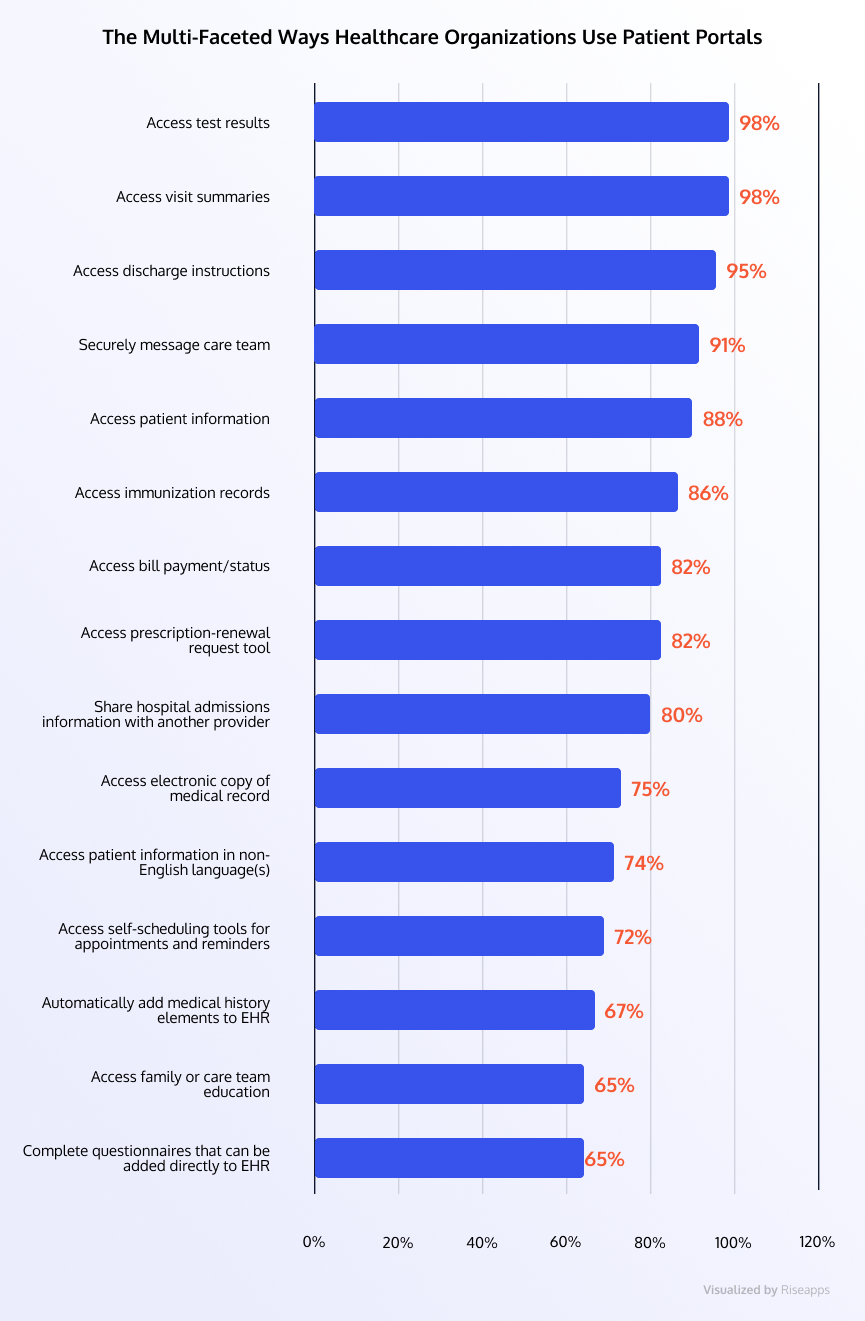
Developing a custom patient portal solution requires careful consideration and deep understanding of multiple factors, starting with their capabilities and specific business needs. Let’s start by breaking down the concept and exploring its critical components.
What Is Patient Portal: Key Differentiators
A patient portal is a secure online platform that provides patients with convenient, 24-hour access to their health information from anywhere with an internet connection. Its goal is to help patients engage with their healthcare providers and manage their health more effectively.
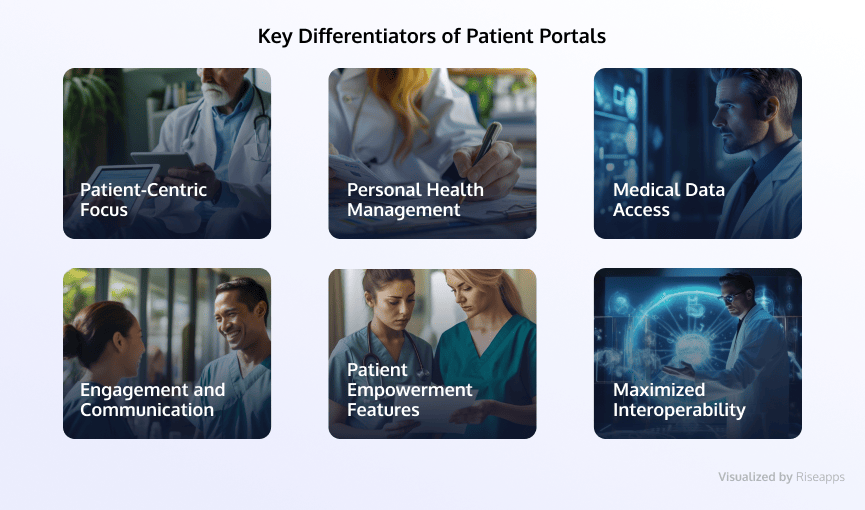
Patient portals stand out in the healthcare landscape due to their patient-centric focus, prioritizing individual empowerment and engagement. Unlike other healthcare solutions, patient portals emphasize patient needs and preferences, fostering a collaborative approach to care management.
Additionally, their interoperability features enable seamless integration with EHR systems, facilitating efficient sharing of health information across care settings.
The Diversity of Patient Portal Solutions
Standalone vs. Integrated Systems
Integrated patient portal solutions seamlessly connect with various healthcare systems and third-party services (LIS, RIS, HIEs, telehealth platforms, etc.), while standalone patient portal software systems operate independently in the healthcare field without relying on other applications.
While integrated portals are known for enhancing the solution’s functionality, interoperability, and the overall patient experience, there are still cases where standalone portals can be a more suitable option, particularly for healthcare providers with specific feature requirements, specialized workflows or those seeking greater flexibility in customization.
Open, Closed, and Hybrid Portals
Open patient portals cater to smaller or private practices by providing round-the-clock access to medical information and offering features such as appointment booking, bill payment, and prescription renewals through easy-to-use apps. They serve as the convenience stores of healthcare management, ensuring accessibility and convenience for patients at all times.
In contrast, closed patient portal software, typically utilized by larger medical practices, offers more selective access to patient information and may lack additional features like appointment booking or bill payments. Consequently, hybrid portals strike a balance between the two, providing limited access to patient medical history while still accommodating essential patient engagement functions.
Patient Portal Software Development and Its Impact on Healthcare Delivery
Patient portals have proven their benefits for both patients and care providers. These platforms drive greater efficiency, productivity, and care coordination, ultimately leading to improved patient outcomes and a positive impact on the healthcare ecosystem.
A vivid example of the efficiency of patient portal software is demonstrated by Hull University Teaching Hospitals, which experienced the following impacts within the first few months of adopting a patient portal solution:
- Avoided 96 hours of face-to-face appointments
- Saved approximately 46 hours of annual administrative work
- Reduced telephone messages by nearly 50%
- Reduced the length of offline appointments
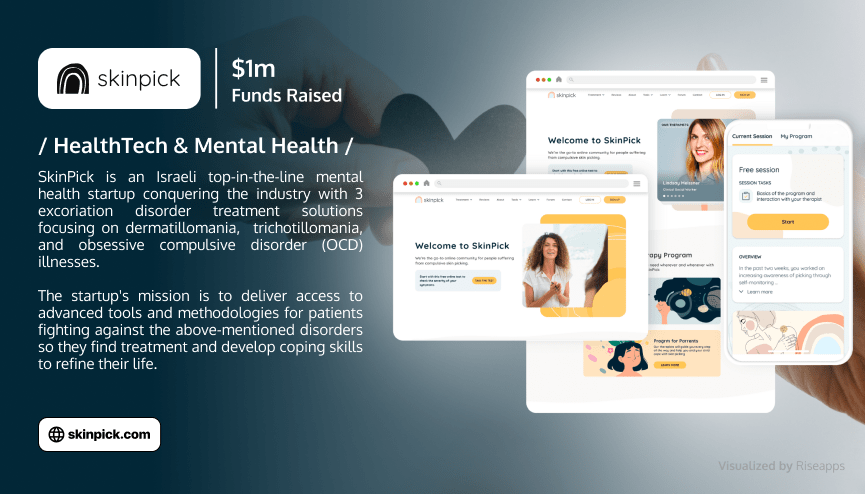
Similarly, a patient portal system developed by Riseapps for Skinpick yielded remarkable outcomes:
- Increased web conversion rate by 30%
- Doubled platform usage growth
- Raised user satisfaction rate by 45%
Skinpick patient portal development led to a significant increase in patient engagement, with app users creating five times more custom therapy tools.
How Patient Portal Development Redefines Care Efficiency
While the results are impressive, you might wonder what factors contribute to the success of healthcare web portal development. Therefore, let’s delve deeper into the specific capabilities of patient portals that truly make a difference.
Convenience for Patients and Providers
Patient portals offer a comprehensive suite of features that empower patients to take control of their healthcare journey. From online appointment scheduling to accessing personal health data, viewing lab test results, or requesting prescription refills, these capabilities enhance convenience and improve the overall patient experience.
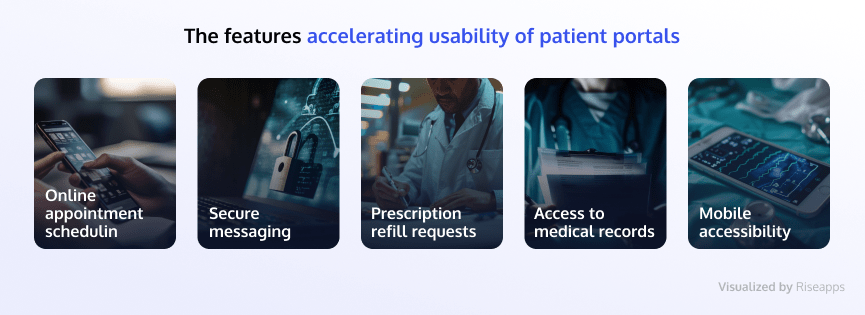
Streamlined Administrative Tasks
Online portals significantly streamline healthcare operations. They not only reduce the need for manual paperwork and data entry but also facilitate seamless coordination across different departments within the healthcare organization.
As a result, medical institutions can optimize their resources, minimize administrative errors, streamline the delivery of lab results, and focus more on delivering high-quality patient care.
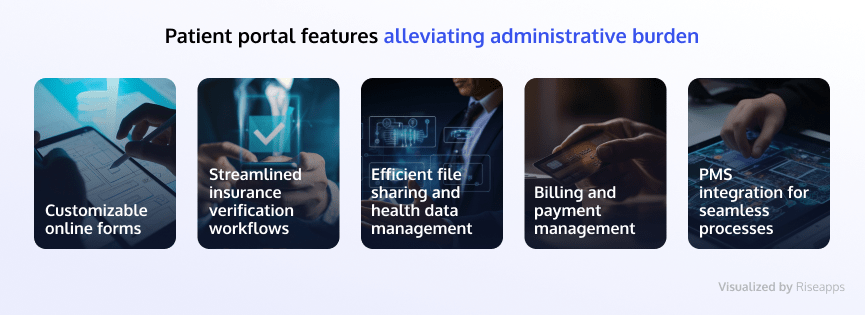
Reduced No-Show Rates
Patient portals typically offer online appointment management features and custom reminders, enabling patients to easily schedule, reschedule, or cancel appointments based on their availability and preferences. This reduces clinic visit no-show rates and improves appointment adherence.
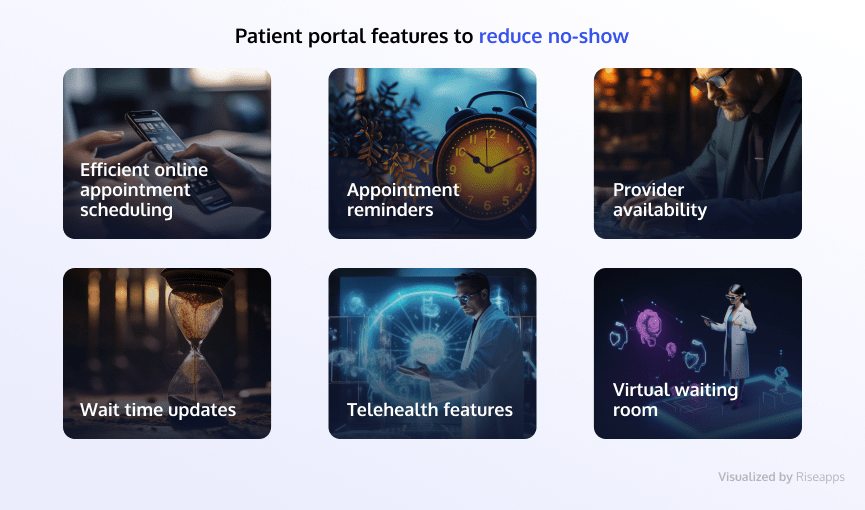
Improved Patient-Doctor Interactions
Multiple communication options and secure messaging between patients and physicians allow patients to ask questions, seek advice, or clarify information without the need for office visits or phone calls, which is particularly beneficial for older adults or patients with chronic conditions.
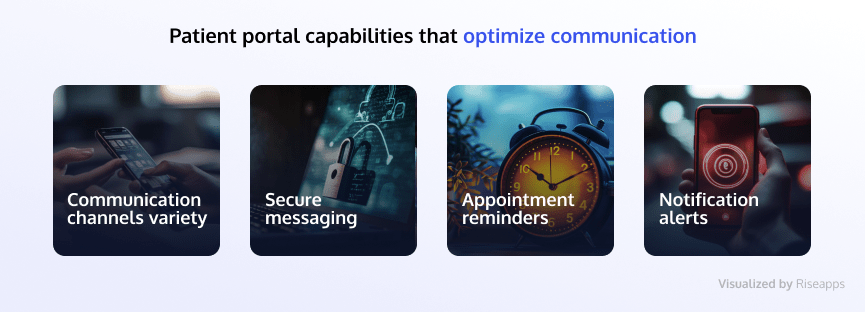
Assessing Patient Portal Software Vendors: Top Features and Bottlenecks
Industry directories showcase close to 100 off-the-shelf patient portal software solutions. While each possesses its advantages and drawbacks, analyzing the current market offerings provides actionable insights for effective patient portal development. Let’s delve in.
Simple Practice
Simple Practice offers a patient portal as a part of its electronic health record (EHR system) suite, providing clients with the convenience of online booking, electronic forms management, and patient interactions.

Simple Practice offers a set of features for managing electronic health records, doctor’s office visits scheduling, and telehealth consultations, with users praising its responsiveness to feedback and overall improvements.
However, challenges with billing, inconsistent appointment reminders, and limited customization options pose drawbacks. Users also cite concerns about the software’s cost, navigation intuitiveness and occasional technical issues, from slow performance to feature malfunctions and mobile app efficiency.
Mend
Mend is a telehealth platform designed to streamline healthcare delivery and enhance patient interactions, offering a range of features including secure video doctor’s consultation, appointment booking, and document management and others.

Mend is praised for its simple interface, telehealth convenience, and proactive customer service. Additionally, it features sophisticated billing tools, including custom online intake forms, autopay enrollment for automated credit card billing, and easy online payments.
However, occasional slow performance, lag times, and malfunctions when scheduling appointments or entering client information are notable reported inefficiencies. Additionally, Mend’s UX customization options are limited, which can be particularly challenging for practices with unique workflow requirements or specific branding needs.
TheraNest
TheraNest Mental Health is a web-based solution and Apple app designed for managing psychology and mental health practices that caters to independent practitioners, educational institutions, and non-profit organizations by streamlining appointment booking, note-taking, billing, and other patient-related processes.

Theranest offers a wide range of features for both clinical and administrative needs. By centralizing scheduling, documentation, billing, and client communication in one platform, Theranest simplifies practice management, saving time and resources for practitioners.
However, the solution’s disadvantages include various billing inefficiencies and difficulties with insurance claims processing. The billing service requires extensive manual tracking of payments and follow-ups with insurers, which might result in delays, inaccuracies, and additional administrative burden.
Pabau
Pabau is an all-in-one software solution designed to streamline and automate clinic management tasks. Suitable for clinics of varying sizes and across diverse industries, it offers a range of features tailored to meet diverse healthcare needs.

Pabau’s functionality consolidates various aspects of healthcare operations including scheduling, personal health record management, and financial tools into one platform with extra marketing tools, flexible reporting functions, and regular updates.
However, Pabau also presents some challenges, from setup difficulties to software downtime. Adopting Pabau involves a steep learning curve and requires time to navigate its features effectively, with users encountering teething problems, technical issues, and the need for extensive trial and error to configure the system to their preferences.
RXNT
RXNT is a cloud-based integrated clinical and practice management system with built-in patient portal functionality. It helps users manage their medical history, treatments, scheduling, billing, and comprehensive care, streamlining various aspects of healthcare administration.

RxNT is praised for its customization options, useful features for chart documentation, and seamless integration with other systems.
However, there are some drawbacks as well, such as occasional tech issues with live chat functionality, patient portal interface and usability challenges, along with dissatisfaction with customer service and communication discrepancies.
White-Label vs Custom: Top Considerations From Patient Portal Software Company
Choosing the most suitable option
Venturing into patient portal development requires recognizing that portals are not one-size-fits-all.
While dozens of out-of-the-box white-label patient portals offer pre-built solutions with some branding and functionality customization, they cannot fully match specific business operations or provide efficient differentiation to the extent that a tailor-made solution can. But what exactly is the difference between these two patient portal adoption approaches? Let’s review.

Tailor-made patient portals are designed from the ground up to meet the exact needs of a healthcare organization, allowing for complete customization and seamless integration with existing systems. Ultimately, investing in a tailor-made portal help clinicians improve efficiency of their medical practices, enhance patient engagement, and ensure long-term scalability that aligns with the evolving needs of the organization.
While tailor-made portals require a longer software development timeline and higher initial investment, they provide the opportunity for a fully personalized and optimized user experience, which can be particularly beneficial for larger healthcare systems or those with complex workflows and regulatory requirements. See the top portal use cases and further considerations regarding both approaches below.
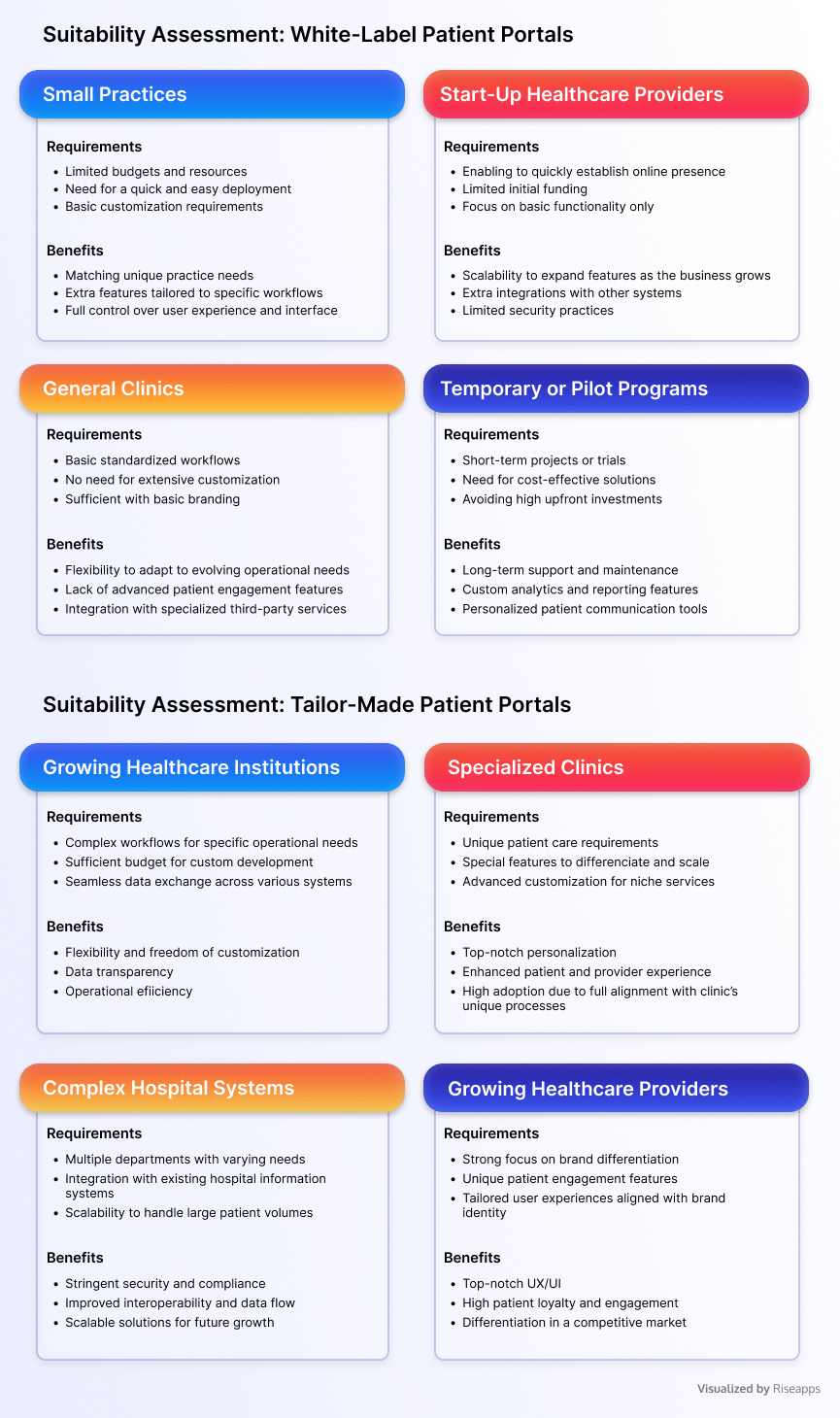
Navigating patient portal development services
Patient portal development services encompass a wide range of options designed to accommodate various requirements, timelines, and financial constraints.
The potential options include:
- Proof of Concept (PoC) entailing the creation of a basic prototype to validate business ideas;
- A minimum viable product (MVP) with essential features to improve patient interactions and operational efficiency;
- Customization of an existing portal solution to more closely align with specific needs;
- Fully-fledged portal development aimed at deploying comprehensive platforms with advanced functionalities to scale further growth;
- Further enhancement of patient portals with advanced features and automated workflows, artificial intelligence (AI), extra integrations for seamless interoperability, and other emerging technologies.
When selecting a patient portal, it’s crucial to consider various factors to ensure the solution meets the specific needs of your healthcare practice. Factors such as the required functionality, integration with existing systems, and compliance with regulatory standards all contribute to both project success and its overall expenses.
By partnering with a skilled technology provider like Riseapps, healthcare organizations can navigate these variables efficiently. With a proven track record of delivering successful HIPAA-compliant patient portal projects on time and within budget, Riseapps offers a reliable and cost-effective software development process. Below, you can find estimated cost ranges for patient portal development based on industry standards and project requirements.
Leveraging a long-term patient portal strategy, one step at a time
One of the best patient portal adoption strategies for ensuring efficiency is to start small and scale as you succeed.
By initially implementing a basic version of the portal to validate the proof of concept, healthcare organizations can move on to a Minimum Viable Product (MVP) to test its functionality, gather user feedback, and make necessary adjustments without a significant upfront investment. By building on a solid foundation through PoC and MVP stages, the patient portal can grow into a comprehensive, highly efficient tool that increases patient engagement, streamlines operations and supports better health outcomes.
As the MVP demonstrates success, additional advanced features can be gradually introduced to develop a fully-fledged patient portal. This phased approach not only minimizes risks and costs but also ensures that the portal evolves in line with the actual needs of patients and physicians.

Riseapps patient portal development approach yielded results for many clients, including:
- Riseapps patient portal and telemedicine app development services led Black Doctor to a $100M revenue goal;
- Boosted patient satisfaction rates and engagement for Kego;
- Rapid app scaling with 30+ new features, gamification flows, and integrations released in under 6 months after the launch of the Amen Clinics app.
Сrafting a winning feature set for a patient portal
By strategically selecting and integrating patient portal features required for operational excellence, healthcare institutions can efficiently drive engagement and improve healthcare outcomes. Start with essential functionalities and gradually incorporate more, ultimately ensuring a comprehensive, highly efficient care delivery tool.
Stage 1: Must-Have Features
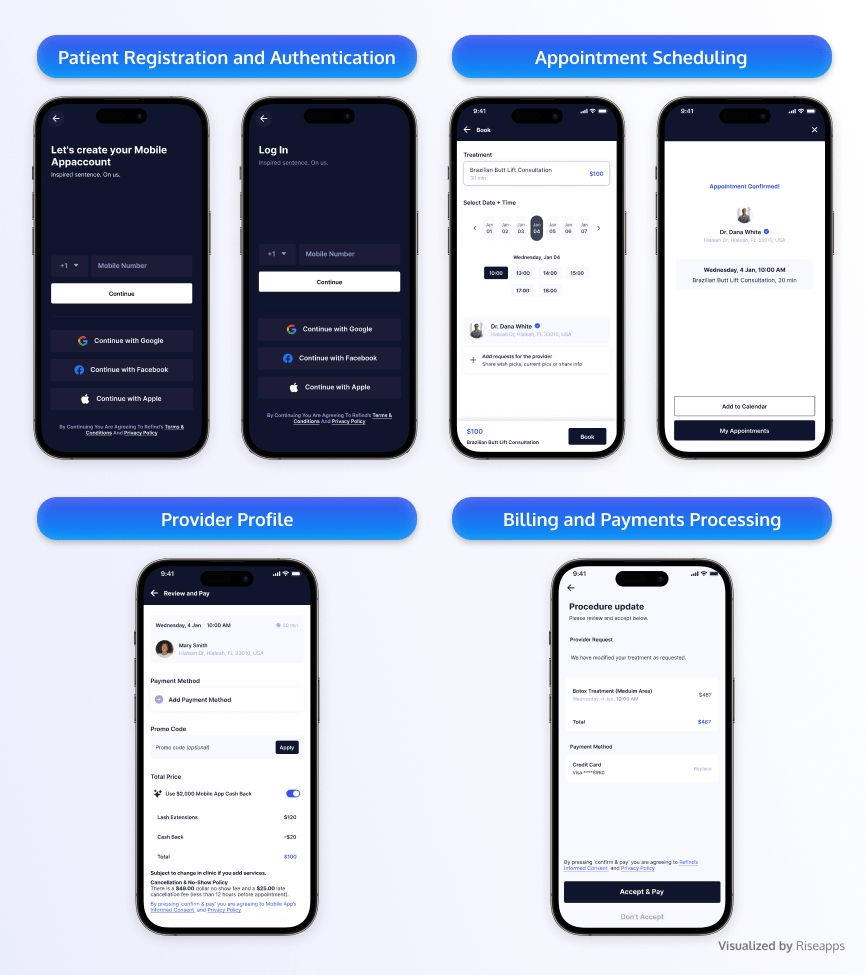
Patient Registration and Authentication
Secure login and user-friendly account creation processes ensure patient data protection and ease of access.
Appointment Scheduling
The ability to schedule appointments online, east rescheduling, and automated reminders improve appointment management and reduce no-shows.
Provider Profile
A comprehensive overview of a healthcare professional’s credentials, specialties, and practice details facilitates informed decision-making for patients seeking care.
Billing and Payment Processing
Online bill viewing and multiple payment options, along with insurance integration, streamline the billing process.
Stage 2: Nice-To-Have Features
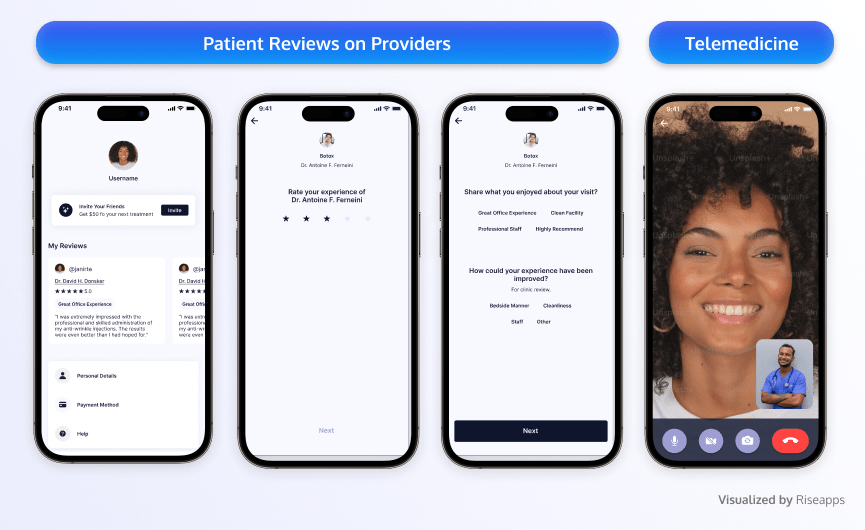
Patient Reviews on Providers
Feedback and ratings based on their experience with healthcare providers and services streamline trust and transparency in healthcare delivery.
Services checkout
A list of services and treatment options by categories streamlines the process of selecting and booking services, ultimately enhancing convenience and accessibility in healthcare delivery.
Telemedicine
Virtual consultations and remote healthcare services expand access to care beyond traditional office visits.
Stage 3: Features on Steroids
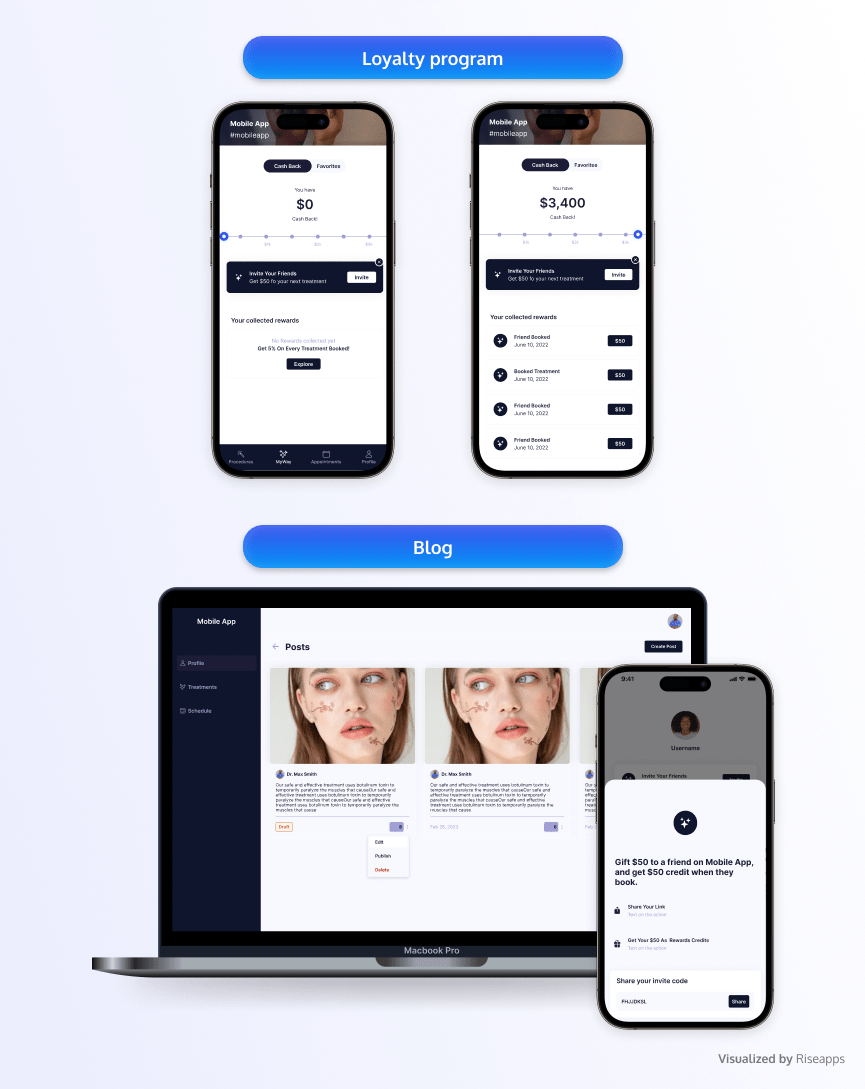
Loyalty program
Rewards and cashback incentives for repeat visits and referrals not only incentivize long-term patient loyalty but also cultivate engagement within the healthcare community, fostering strong relationships between patients and providers.
Referral workflows
Seamless referral processes ensure continuity of care and enhance collaboration.
Educational materials
With access to a library of informative resources and educational content on wellness, nutrition, and preventive care, patients are empowered to make informed decisions and lead healthier lifestyles.
Accelerating Patient Portal Development Success: Top 8 Best Practices
As a patient portal software company with a proven track record of delivering patient-centered solutions, Riseapps thoroughly evaluates clinical needs, resources, and long-term goals for clients before crafting a solution that best suits a specific healthcare environment. Here are some practices we follow to help you achieve patient portal excellence.
Security and Compliance
Ensure that the patient portal is GDPR and HIPAA compliant to safeguard patient data privacy and adhere to industry security regulations. Look for features like data encryption, access controls, and audit trails to mitigate risks of data breaches.
💡 Pro Tip: Comprehensive documentation is an essential step towards creating HIPAA compliant software development as it helps identify potential gaps in security and privacy practices, providing a clear roadmap for corrective actions.
Interoperability
To ensure seamless data exchange with your existing healthcare IT infrastructure, opt for a patient portal app that supports industry-standard protocols like HL7 and FHIR for seamless data exchange.
💡 Pro Tip: EHR system integration is only the tip of an interoperability iceberg. Also, consider other IT systems like laboratory systems, imaging devices, insurance providers, and others.
Usability and User Experience
Crafting a truly user-friendly patient portal design and intuitive navigation requires thorough user testing and feedback collection throughout the portal software development process.
💡 Pro Tip: Consider customizable interfaces, mobile responsiveness, onboarding features, and patient education resources to improve user experience and engagement.
Scalability and Performance
Assess the scalability and performance capabilities of your custom patient portal to accommodate future growth and handle increased user demand, particularly during peak usage periods.
💡 Pro Tip: Look for features like load balancing, caching mechanisms, and scalable infrastructure to ensure reliable performance under heavy usage.
Integration with Third-Party Services
Ensuring smooth integration and interoperability with multiple services can be challenging due to differences in APIs, data formats, and authentication mechanisms. Work closely with the patient portal software development vendor and third-party service providers to establish clear integration requirements upfront.
💡 Pro Tip: Standardized APIs and data formats can simplify your integration efforts throughout software development.
Data Analytics and Reporting
Don’t overlook data analytics and reporting capabilities — advanced dashboards can provide valuable insights for improving care delivery and optimizing medical practice workflows.
💡 Pro Tip: Consider vastly customizing KPIs and reports to gain deeper insights into various aspects of patient care, operational efficiency, and financial performance.
Data Privacy and Consent Management
Implementing granular consent management features and transparent data handling practices is a must for building trust with users. Provide clear explanations of how patient data will be used, including data security measures, access controls, and procedures for data sharing.
💡 Pro Tip: To ensure efficient data consent practices, implement robust mechanisms allowing patients to choose their preferred data collection, processing, and sharing option.
Training and Support
Onboarding is crucial for an efficient patient portal adoption within an organization. User guides, training sessions, and responsive customer support can facilitate seamless adoption and enhance overall satisfaction with the platform.
💡 Pro Tip: Thoroughly discuss user adoption strategy with your vendor and project manager, ensuring the utmost alignment on strategies.
How Riseapps Skyrockets Patient Portal Development Efficiency
Riseapps is a leading provider of patient portal app development services, offering comprehensive solutions tailored to the specific needs of healthcare organizations. With extensive expertise in healthcare software development, we collaborate with startups, SMEs, and enterprise-level vendors to deliver efficient and innovative HIPAA-compliant patient portal solutions.
Thanks to a structured step-by-step approach to clients’ projects, Riseapps delivers patient portals that meet the highest quality standards, align with client objectives, and empower healthcare organizations to enhance patient engagement.
As a result, many of our clients have achieved multi-million revenue milestones through our strategic technology partnership.
Contact us to learn how we drive revenue for healthcare providers.
FAQ
Why are patient portals important?
Patient portals play a crucial role in improving patient engagement and medical practice, enhancing communication between patients and healthcare providers, streamlining administrative tasks, and empowering patients and their family members to take control of their healthcare journey.
What technologies are used to build patient portals?
Custom patient portals are typically built using a combination of front-end and back-end technologies such as HTML, CSS, JavaScript, and frameworks like Angular or React for the user interface, and server-side languages like Java, Python, or Node.js for the backend.
How can I ensure the success of my patient portal development project?
To ensure the success of a patient portal app development project, it's essential for project manager and healthcare stakeholders to conduct thorough research and planning, engage stakeholders early in the software development process, prioritize user experience, secure a proficient QA specialist to test the portal rigorously before launch, provide adequate training and support to users, and continuously iterate and improve based on feedback and usage analytics.
What features should a patient portal include?
Must-have features of a basic patient portal include secure messaging, appointment scheduling, access to medical records, prescription refill requests, telehealth capabilities, and educational resources. However, the list can go on and on depending on your specific requirements.
Contact Us






